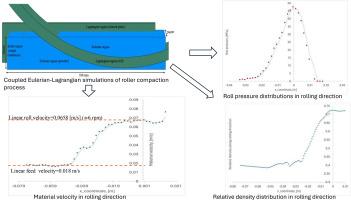欧拉-拉格朗日耦合法在轧辊压实模型中的应用
IF 4.6
2区 工程技术
Q2 ENGINEERING, CHEMICAL
引用次数: 0
摘要
粉末的辊压成形过程是一个具有大变形和复杂接触相互作用的稳态过程。传统的建模方法是采用任意拉格朗日-欧拉(ALE)方法,该方法需要频繁地对拉格朗日域进行重新网格划分以保证求解精度。为了克服这一限制,本研究探索了耦合欧拉-拉格朗日(CEL)方法,该方法可以适应大变形而不产生网格畸变。CEL方法在Abaqus/Explicit中实现,以施加的入口进料速度和零出口压力作为欧拉边界条件。稳态解是通过一般的瞬态(非稳态)模拟实现的。为了提高显式分析的计算效率,通过增加材料密度来人为地缩短模拟时间。结果表明,CEL方法在准确预测轧辊压实过程的关键特性方面具有强大的潜力,与实验测量和文献中报道的基于ale的模拟结果吻合良好。研究还表明,虽然网格尺寸对界面精度有显著影响,但对稳定时间增量没有影响。总的来说,CEL方法提供了一种很有前途的替代方案,可以模拟没有网格变形的滚筒压实,并提供更深入地了解滚筒-粉末相互作用。本文章由计算机程序翻译,如有差异,请以英文原文为准。

Application of the coupled Eulerian-Lagrangian method to the roller compaction modelling
The roller compaction (RC) process of powders is a steady-state operation characterized by large deformations and complex contact interactions. Traditionally, it is modelled using the Arbitrary Lagrangian–Eulerian (ALE) method, which requires frequent remeshing of the Lagrangian domain to preserve solution accuracy. To overcome this limitation, this study explores the Coupled Eulerian–Lagrangian (CEL) method, which can accommodate large deformations without mesh distortion.
The CEL approach is implemented in Abaqus/Explicit, with an imposed inlet feed velocity and zero outlet pressure as Eulerian boundary conditions. A steady-state solution is achieved through a general transient (non-steady-state) simulation. To improve computational efficiency of the explicit analysis, the simulation time is artificially reduced by increasing the material density.
The results highlight the strong potential of the CEL method to accurately predict the key characteristics of the roll compaction process, showing good agreement with both experimental measurements and ALE-based simulations reported in the literature. The study also shows that while mesh size significantly affects interface accuracy, it does not influence the stable time increment. Overall, the CEL approach offers a promising alternative for simulating roller compaction without mesh distortion and provides deeper insight into roller-powder interactions.
求助全文
通过发布文献求助,成功后即可免费获取论文全文。
去求助
来源期刊

Powder Technology
工程技术-工程:化工
CiteScore
9.90
自引率
15.40%
发文量
1047
审稿时长
46 days
期刊介绍:
Powder Technology is an International Journal on the Science and Technology of Wet and Dry Particulate Systems. Powder Technology publishes papers on all aspects of the formation of particles and their characterisation and on the study of systems containing particulate solids. No limitation is imposed on the size of the particles, which may range from nanometre scale, as in pigments or aerosols, to that of mined or quarried materials. The following list of topics is not intended to be comprehensive, but rather to indicate typical subjects which fall within the scope of the journal's interests:
Formation and synthesis of particles by precipitation and other methods.
Modification of particles by agglomeration, coating, comminution and attrition.
Characterisation of the size, shape, surface area, pore structure and strength of particles and agglomerates (including the origins and effects of inter particle forces).
Packing, failure, flow and permeability of assemblies of particles.
Particle-particle interactions and suspension rheology.
Handling and processing operations such as slurry flow, fluidization, pneumatic conveying.
Interactions between particles and their environment, including delivery of particulate products to the body.
Applications of particle technology in production of pharmaceuticals, chemicals, foods, pigments, structural, and functional materials and in environmental and energy related matters.
For materials-oriented contributions we are looking for articles revealing the effect of particle/powder characteristics (size, morphology and composition, in that order) on material performance or functionality and, ideally, comparison to any industrial standard.
 求助内容:
求助内容: 应助结果提醒方式:
应助结果提醒方式:


